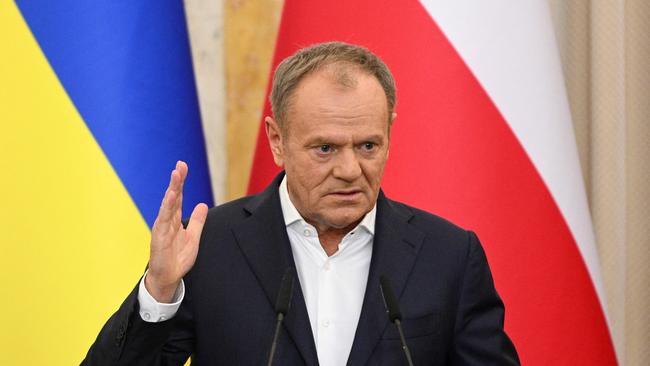How Poland became one of Europe’s big success stories
The country’s focus on productivity and EU membership have been key to growth rates that are the envy of bigger economies.

Built in extreme cold in the 1970s and 1980s, the 4100-km-plus Baikal-Amur mainline railway pierces through eastern Siberia to the Sea of Japan. It is one of countless pieces of technology fashioned during the US-Soviet space race to have accelerated the development of personal electronics.
In a command economy encompassing various countries including the USSR, the resources of each member state were typically channelled toward reaching specific goals mapped out by a centralised political committee.
When the Iron Curtain still divided East and West, Poland was central to this process and, in terms of innovative achievements, outperformed many of its Soviet peers.
The Tadeusz Sendzimir steelworks in Nowa Huta, a district in Krakow, built in the mid 20th century, was fully operational until 2020 as Poland’s second-largest steel plant before ArcelorMittal, which acquired the plant 19 years ago, shifted production to the Dąbrowa Gornicza steel facility, another Soviet-era relic.
Roads and bridges built during Poland’s time in the Council for Mutual Economic Assistance, a group of central and eastern European countries with which Moscow tried to forge closer economic ties via huge infrastructure projects, remain central to the functioning of the economy after the assets were modernised.
These feats of engineering are testament to Poland’s industriousness that it was able to reach such economic heights amid restricted access to western resources. That thread of manufacturing, technological and scientific innovation has fuelled Poland’s growth since its transition from Soviet state to market economy. From 1990 to 2023, Poland’s GDP per head rose from $US6200 to $US48,000, among the best improvements in living standards anywhere in the world.
The International Monetary Fund thinks that Polish GDP will expand by 3 per cent this year, by 3.5 per cent next year and 3.4 per cent in 2026. Many Group of 7 finance ministers would view these rates with envy. Astoundingly, they are a slight slowdown from recent highs. Between 2004 and 2019, the Polish economy grew at an average annual rate of about 4 per cent, OECD stats show.
According to estimates from the World Bank, there is a chance that Poland’s GDP per person will outstrip the UK’s in the coming years if each country remains on its present growth trend.
Membership of another centralised body, the European Union, has aided Poland’s rapid economic development. After joining in 2004, the country immediately benefited from access to the single market, European labour, more public money, foreign direct investment flows and greater investor interest.
“It is difficult to overstate the importance of EU membership for Poland’s economic development,” Kevin Daly, co-head of the economics team covering central and eastern Europe, the Middle East and Africa at Goldman Sachs, said.
“Easy access to the EU single market is a major draw for foreign direct investment into Poland, which has been the primary driver of economic growth.”
In the first decade of EU membership, lots of Poles emigrated to other countries to capitalise on a wider breadth of job opportunities and higher wages.
Richer EU members, such as Britain and Germany, benefited from this influx of industrious and skilled labour, most notably in their construction sectors. Initially, a large flow of payments from Polish expats flowed back to their families in the homeland.
“Poles then returned home to bring back their newly developed skills and founded new businesses in Poland,” Tomasz Wieladek, chief European economist at T Rowe Price, the global asset manager, said. Dissemination of these skills into Poland’s key sectors has fortified the economy.
Integration of democratic institutions, a requirement of EU membership, has been important for “sustainable development”, Rafal Benecki, the chief economist in Poland at the Dutch bank ING, said.
The value of this democratic foundation has been thrown into sharp focus amid the near 10-year rule of the populist Law and Justice Party, which tried to erode judicial independence and gay rights.
Civic Coalition, a patchwork of parties headed by Donald Tusk, the Prime Minister, to form a majority government after last year’s elections, has set about reversing some of these democratic attacks.
Nicholas Farr, emerging Europe economist at Capital Economics, said: “While it’s difficult to know how the economy would have performed without EU membership, a comparison with eastern Europe’s non-EU countries suggests Poland has enjoyed particularly large dividends from integrating with western Europe.”
The composition of Poland’s output is typical of an economy that is moving from middle income to high-income status. Manufacturing remains core, but there is a rapidly growing services industry, most notably in the financial and technology sectors.
Blik, a payment authorisation provider viewed as the “Polish PayPal”, and TenderHut, a software developer, are leading technological lights. Białystok, a city in the northeast of the country, has been dubbed the “Silicon forest” owing to its high concentration of fast-growing tech start-ups.
According to Goldman Sachs, manufacturing accounts for about 20 per cent of GDP, about double the size of the UK’s. Orlen and KGHM lead the industry. Broadly speaking, this level of manufacturing output is the same as Hungary, the Czech Republic and Romania, comparable former Soviet EU countries.
Greater reliance on production means that Poland is a trading powerhouse; about 30 per cent of GDP is generated from goods exports, most of which flow into Europe.
Construction continues to drive the economy, which Benecki said was partly down to the legacy of the Second World War. “Poland was one of the most destroyed European economies. Polish society was subject to forced displacement, so it had a high deficiency of flats after 1989.”
Relatively cheap labour costs coupled with robust productivity has helped Polish manufacturers to keep prices competitive, incentivising European neighbours to tap into its exports.
However, Farr said “this is just one part of the story. Poland’s focus on improving the productivity of its workforce has helped it excel relative to others in eastern Europe too. Poland has a very good education system for a country at its stage of development.” Attending university is free for Polish citizens.
Export-dependent countries, many of which are located in Europe, such as Germany, are staring down the barrel of steeper US import tariffs once Donald Trump enters the White House next month.
“Poland is exposed to this but not especially so relative to other European economies,” Daly said, mostly owing to minimal trade between Poland, the United States and China.
Given the Labour government’s emphasis on improving living standards in the UK, Chancellor Rachel Reeves and Sir Keir Starmer should look outwards to learn from countries such as Poland that are meeting this end.
Wieladek said that UK regulation should “protect consumers, but also promote growth at the same time”, central to Poland’s policy-making.
Daly was more succinct: “While Poland continues to benefit from membership of the EU, the UK’s relative living standards have been damaged by its departure. The most obvious way of undoing this harm would be to rejoin the EU single market.”
How special economic zones have charged growth
Central to Poland’s transformation have been the country’s business-friendly special economic zones (SEZs), which have topped global rankings for the past decade and which have enabled the country’s foreign direct investment to grow from €44 billion to €314 billion in two decades (Paulina Olszanka writes).
The 14 zones, strategically placed across the country, offer favourable business conditions to both foreign and domestic businesses to encourage investment and on-the-ground activity, with the country drawing in investors with significant tax breaks.
“We’ve found the SEZ provides investors with unique support, not only at the stage of preparation or implementation of the investment, but also after the launch of operational activities,” Maciej Dudzic, president of Elemental Strategic Metals, a metals recycling manufacturer operating in the Katowice special economic zone, said.
“The range of services offered includes assistance in identifying industrial properties with the features desired by the investor, support in contacts with local governments and administration as well as investment incentives in the form of public aid.”
For eight years in a row, the Katowice special economic zone has been singled out in particular, with fDi Intelligence, the English-language bi-monthly news and foreign direct investment (FDI) publication, naming it the best zone in Europe for industry.
Taking in several large cities, 600 businesses and a total investment of more than €10 billion, the zone is in the historical industrial heartland of Silesia, once the richest part of the country. It is now an investment hub with a strong automotive industry, as well as other sectors like glass, steel, food and wood processing.
fDi Intelligence also noted Katowice’s emphasis on good industry practice, such as digitisation, robotisation and sustainability.
“Without the help we had from the economic zone we would not have been able to secure our new metals production plant and the investment would not have been turned around in record time,” Dudzic said.
“It is obvious that the SEZ, over the course of many years, have become an extremely important factor stimulating the development of industry and new investments. The support offered has led to the implementation of multi-billion investment projects, translating into a noticeable increase in the competitiveness of the Polish economy, but also, at the local level, into the creation of new jobs,” Dudzic said.
“Importantly, a significant part of the investors are local companies, often small or medium-sized, sometimes co-operating with plants built by large players. It seems that for these smaller companies, with limited resources or without the support of consulting companies, the activity of the zones is of exceptional importance.”
The Times


